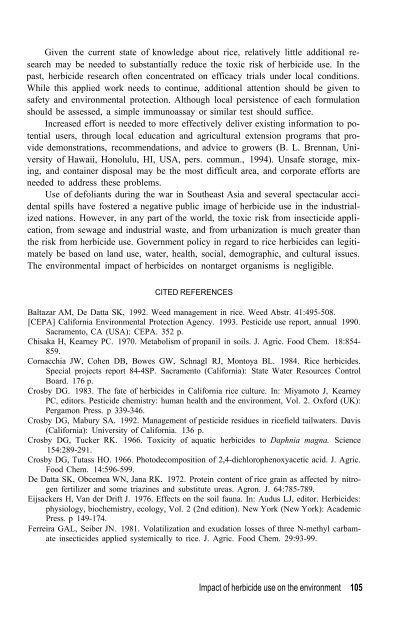HERBICIDES in Asian rice - IRRI books - International Rice ...
HERBICIDES in Asian rice - IRRI books - International Rice ...
HERBICIDES in Asian rice - IRRI books - International Rice ...
Create successful ePaper yourself
Turn your PDF publications into a flip-book with our unique Google optimized e-Paper software.
Given the current state of knowledge about <strong>rice</strong>, relatively little additional research<br />
may be needed to substantially reduce the toxic risk of herbicide use. In the<br />
past, herbicide research often concentrated on efficacy trials under local conditions.<br />
While this applied work needs to cont<strong>in</strong>ue, additional attention should be given to<br />
safety and environmental protection. Although local persistence of each formulation<br />
should be assessed, a simple immunoassay or similar test should suffice.<br />
Increased effort is needed to more effectively deliver exist<strong>in</strong>g <strong>in</strong>formation to potential<br />
users, through local education and agricultural extension programs that provide<br />
demonstrations, recommendations, and advice to growers (B. L. Brennan, University<br />
of Hawaii, Honolulu, HI, USA, pers. commun., 1994). Unsafe storage, mix<strong>in</strong>g,<br />
and conta<strong>in</strong>er disposal may be the most difficult area, and corporate efforts are<br />
needed to address these problems.<br />
Use of defoliants dur<strong>in</strong>g the war <strong>in</strong> Southeast Asia and several spectacular accidental<br />
spills have fostered a negative public image of herbicide use <strong>in</strong> the <strong>in</strong>dustrialized<br />
nations. However, <strong>in</strong> any part of the world, the toxic risk from <strong>in</strong>secticide application,<br />
from sewage and <strong>in</strong>dustrial waste, and from urbanization is much greater than<br />
the risk from herbicide use. Government policy <strong>in</strong> regard to <strong>rice</strong> herbicides can legitimately<br />
be based on land use, water, health, social, demographic, and cultural issues.<br />
The environmental impact of herbicides on nontarget organisms is negligible.<br />
CITED REFERENCES<br />
Baltazar AM, De Datta SK, 1992. Weed management <strong>in</strong> <strong>rice</strong>. Weed Abstr. 41:495-508.<br />
[CEPA] California Environmental Protection Agency. 1993. Pesticide use report, annual 1990.<br />
Sacramento, CA (USA): CEPA. 352 p.<br />
Chisaka H, Kearney PC. 1970. Metabolism of propanil <strong>in</strong> soils. J. Agric. Food Chem. 18:854-<br />
859.<br />
Cornacchia JW, Cohen DB, Bowes GW, Schnagl RJ, Montoya BL. 1984. <strong>Rice</strong> herbicides.<br />
Special projects report 84-4SP. Sacramento (California): State Water Resources Control<br />
Board. 176 p.<br />
Crosby DG. 1983. The fate of herbicides <strong>in</strong> California <strong>rice</strong> culture. In: Miyamoto J, Kearney<br />
PC, editors. Pesticide chemistry: human health and the environment, Vol. 2. Oxford (UK):<br />
Pergamon Press. p 339-346.<br />
Crosby DG, Mabury SA. 1992. Management of pesticide residues <strong>in</strong> <strong>rice</strong>field tailwaters. Davis<br />
(California): University of California. 136 p.<br />
Crosby DG, Tucker RK. 1966. Toxicity of aquatic herbicides to Daphnia magna. Science<br />
154:289-291.<br />
Crosby DG, Tutass HO. 1966. Photodecomposition of 2,4-dichlorophenoxyacetic acid. J. Agric.<br />
Food Chem. 14:596-599.<br />
De Datta SK, Obcemea WN, Jana RK. 1972. Prote<strong>in</strong> content of <strong>rice</strong> gra<strong>in</strong> as affected by nitrogen<br />
fertilizer and some triaz<strong>in</strong>es and substitute ureas. Agron. J. 64:785-789.<br />
Eijsackers H, Van der Drift J. 1976. Effects on the soil fauna. In: Audus LJ, editor. Herbicides:<br />
physiology, biochemistry, ecology, Vol. 2 (2nd edition). New York (New York): Academic<br />
Press. p 149-174.<br />
Ferreira GAL, Seiber JN. 1981. Volatilization and exudation losses of three N-methyl carbamate<br />
<strong>in</strong>secticides applied systemically to <strong>rice</strong>. J. Agric. Food Chem. 29:93-99.<br />
Impact of herbicide use on the environment 105

















